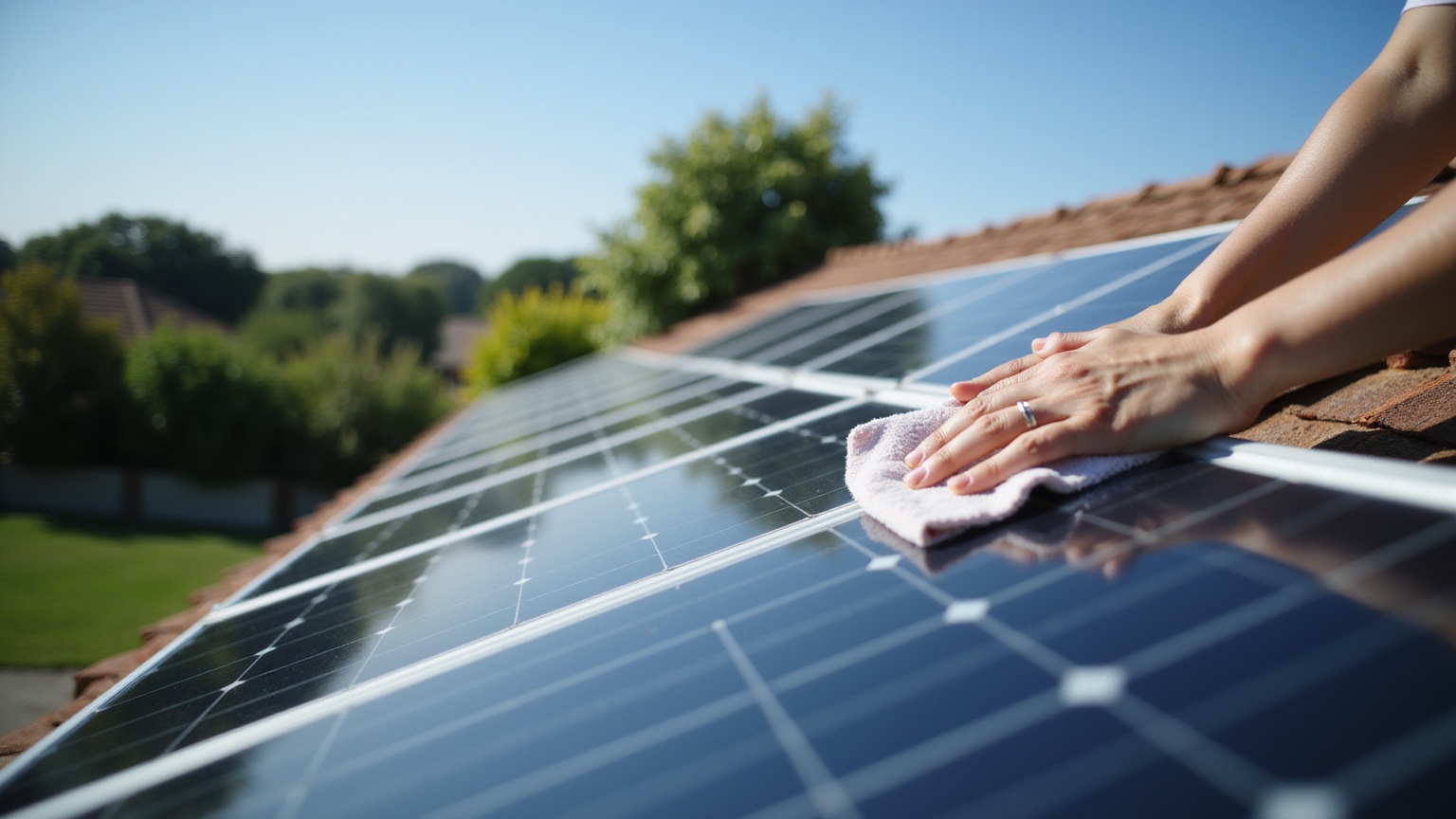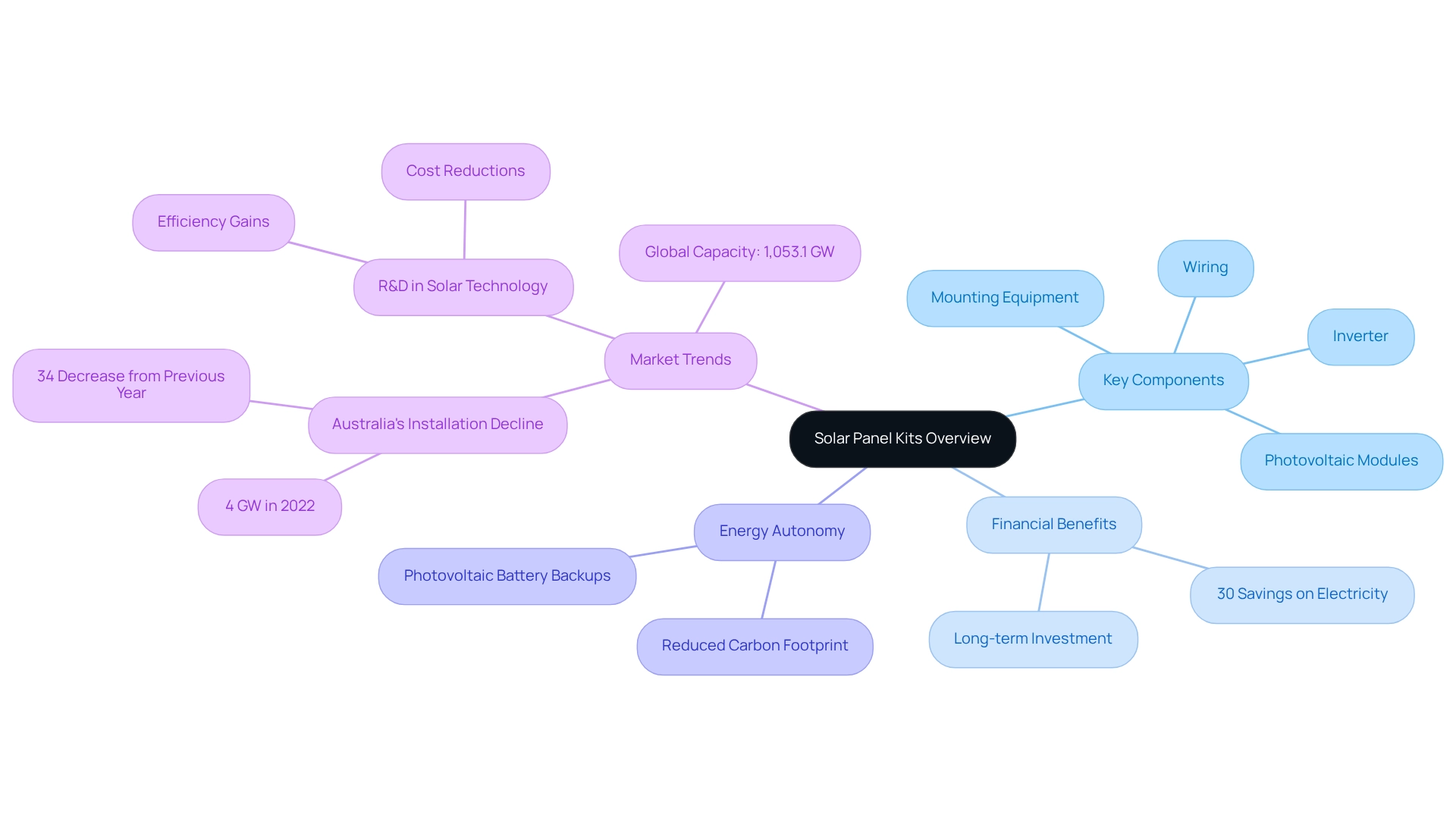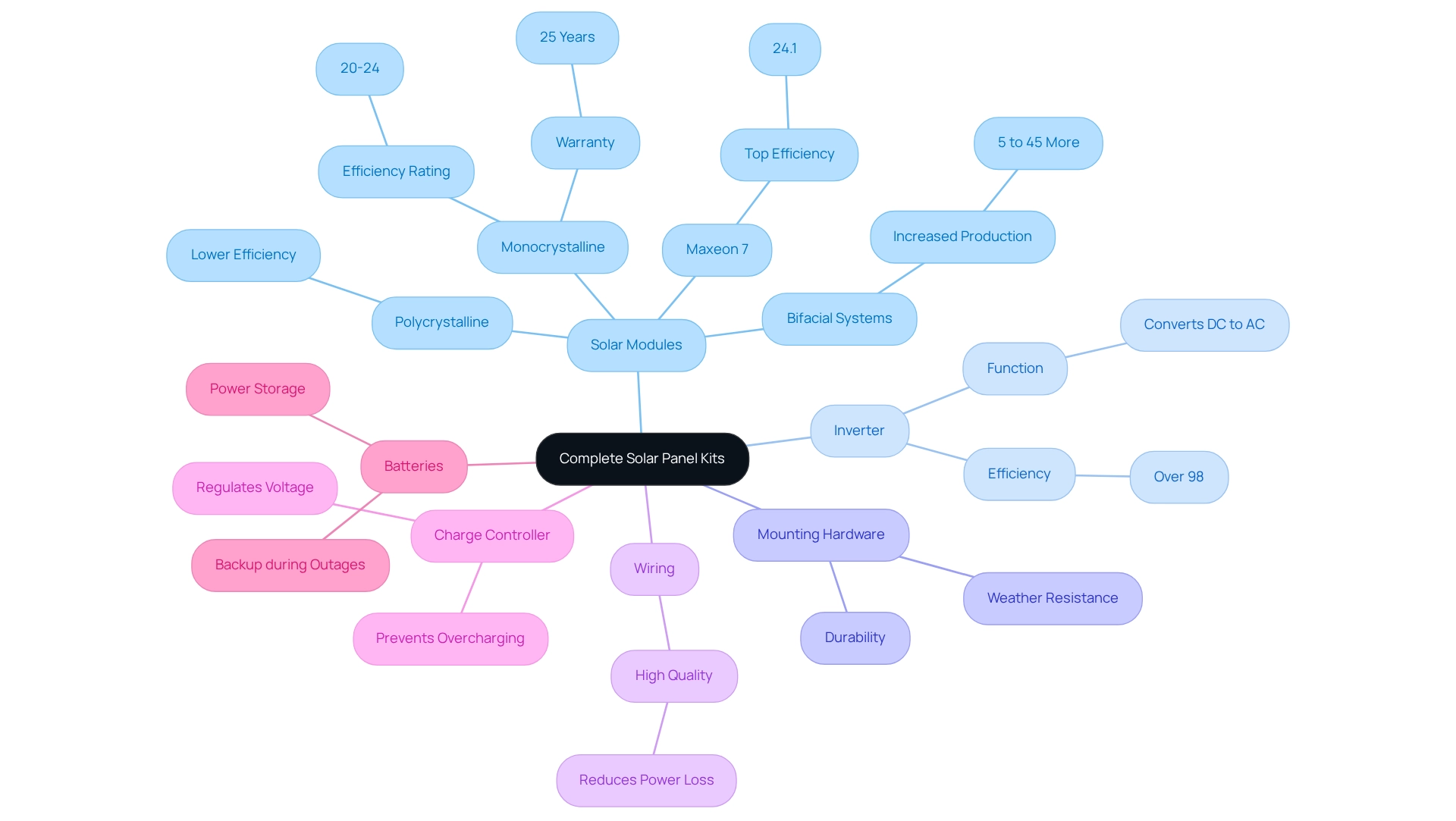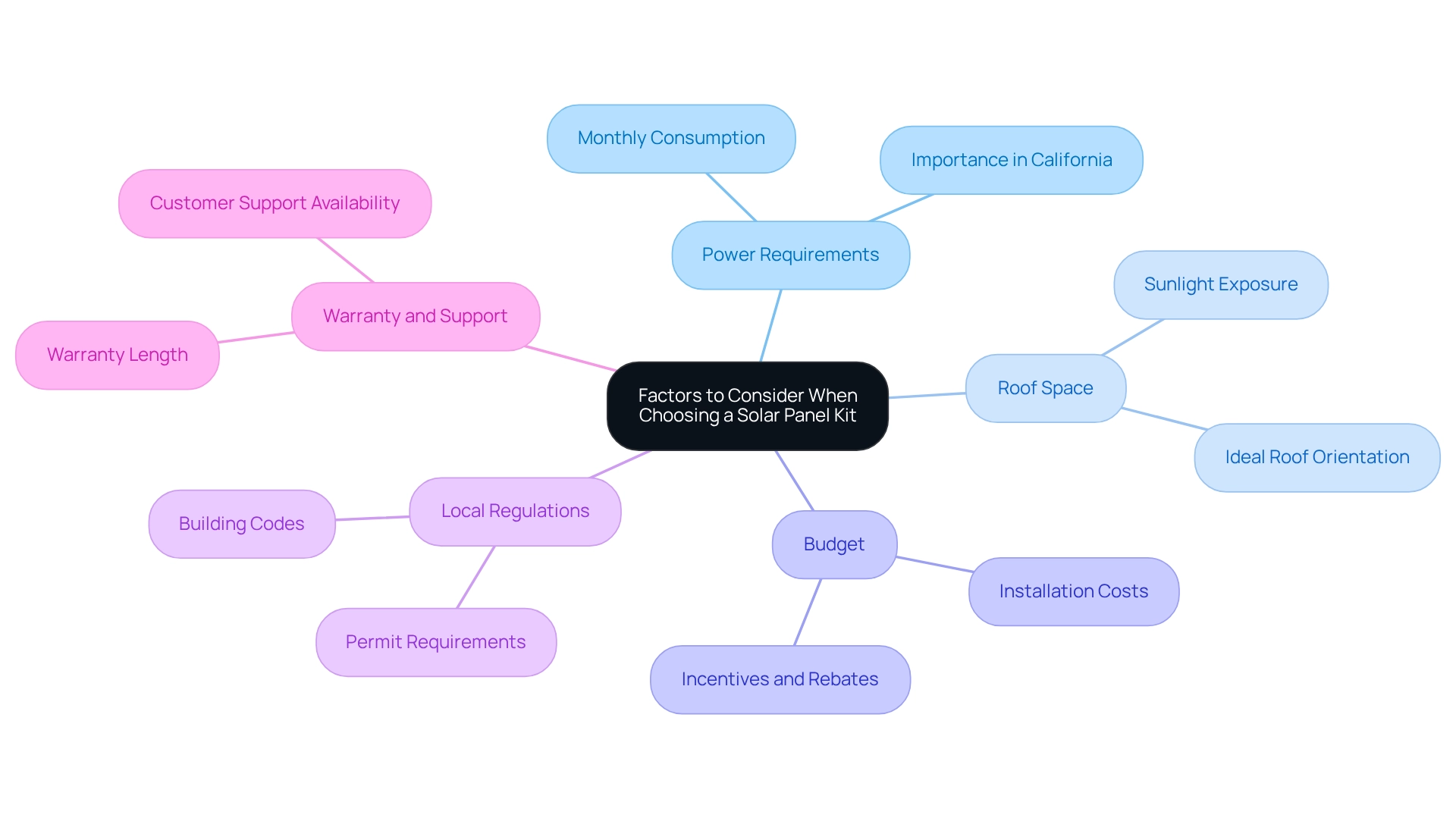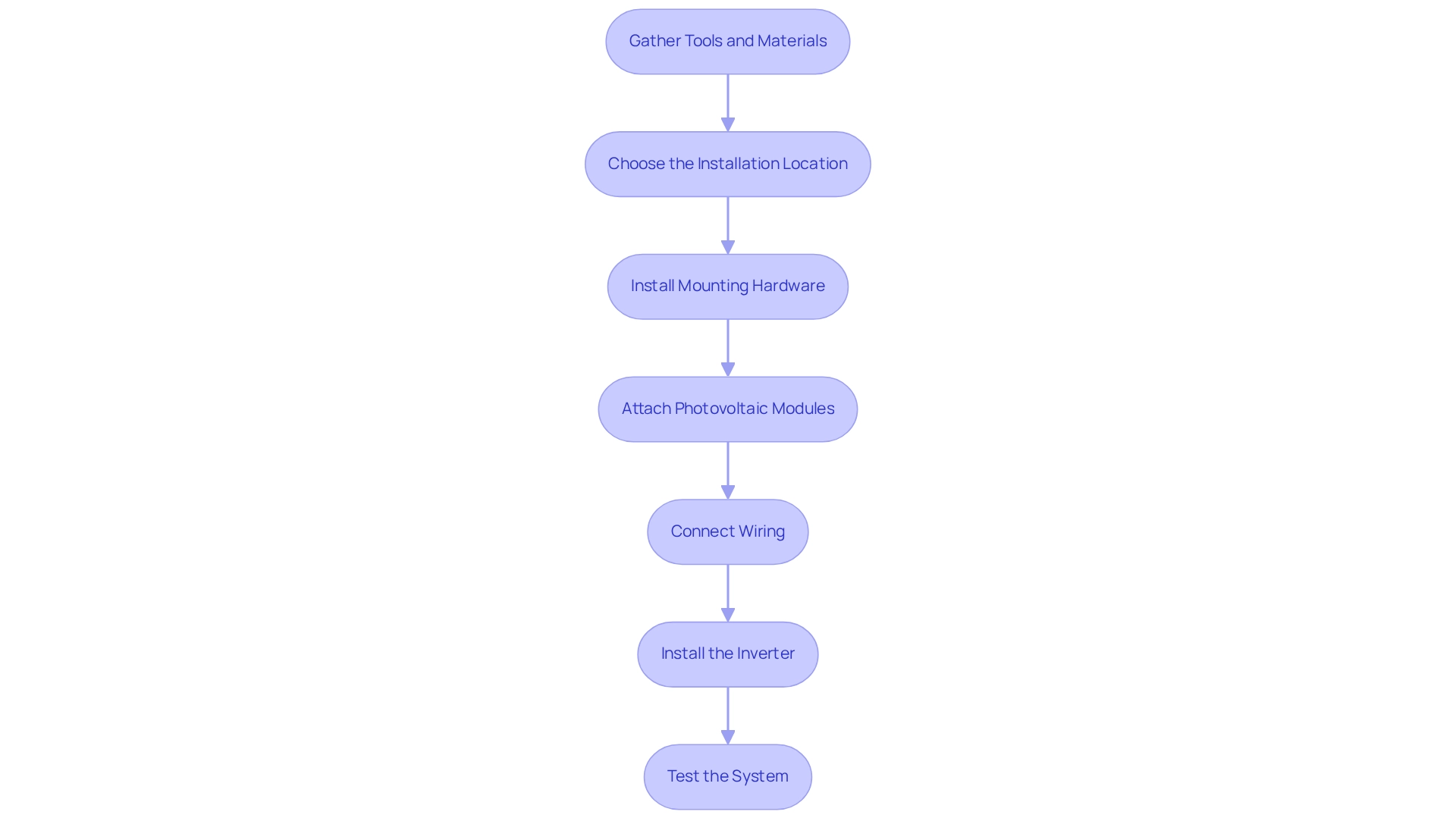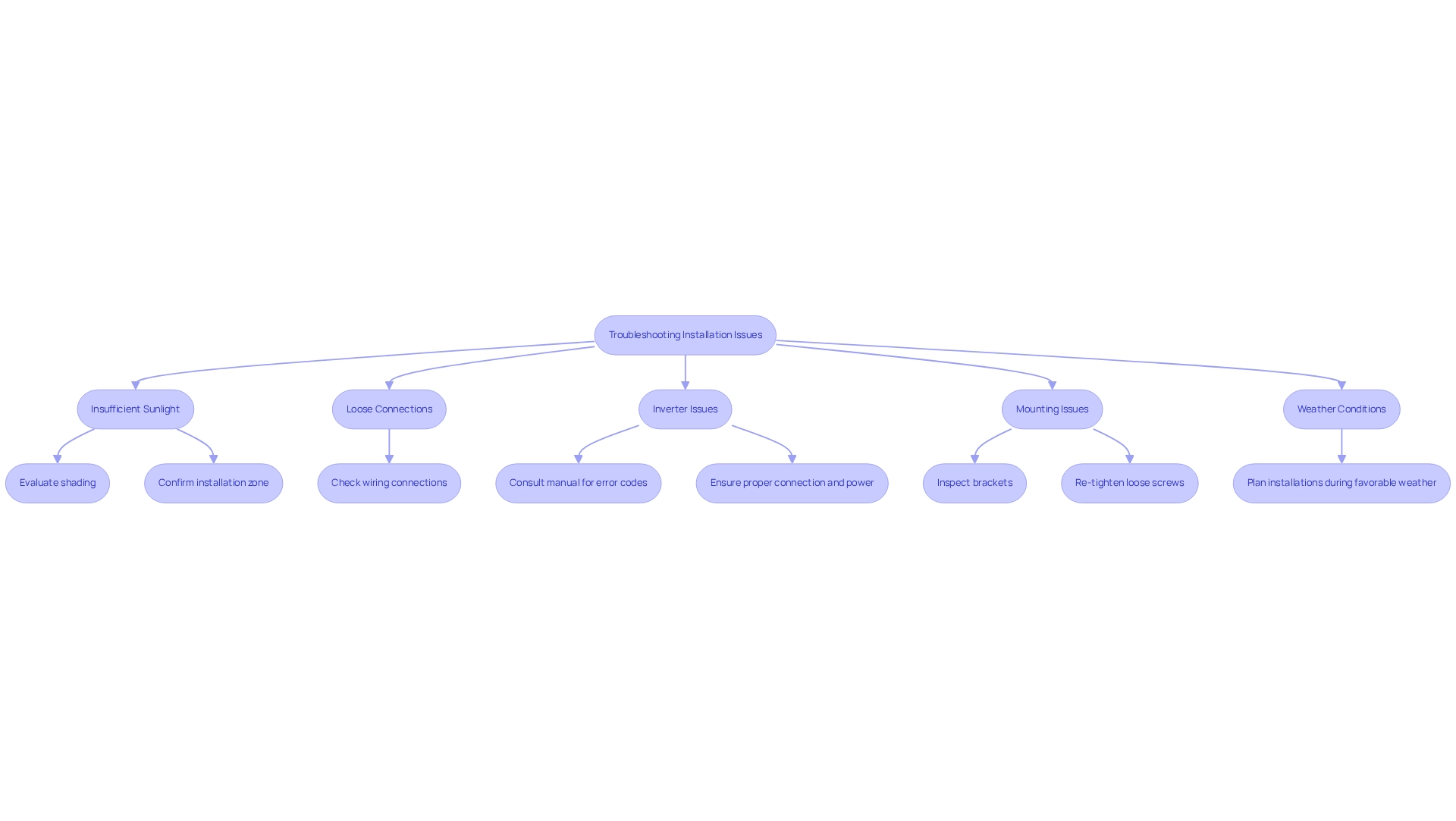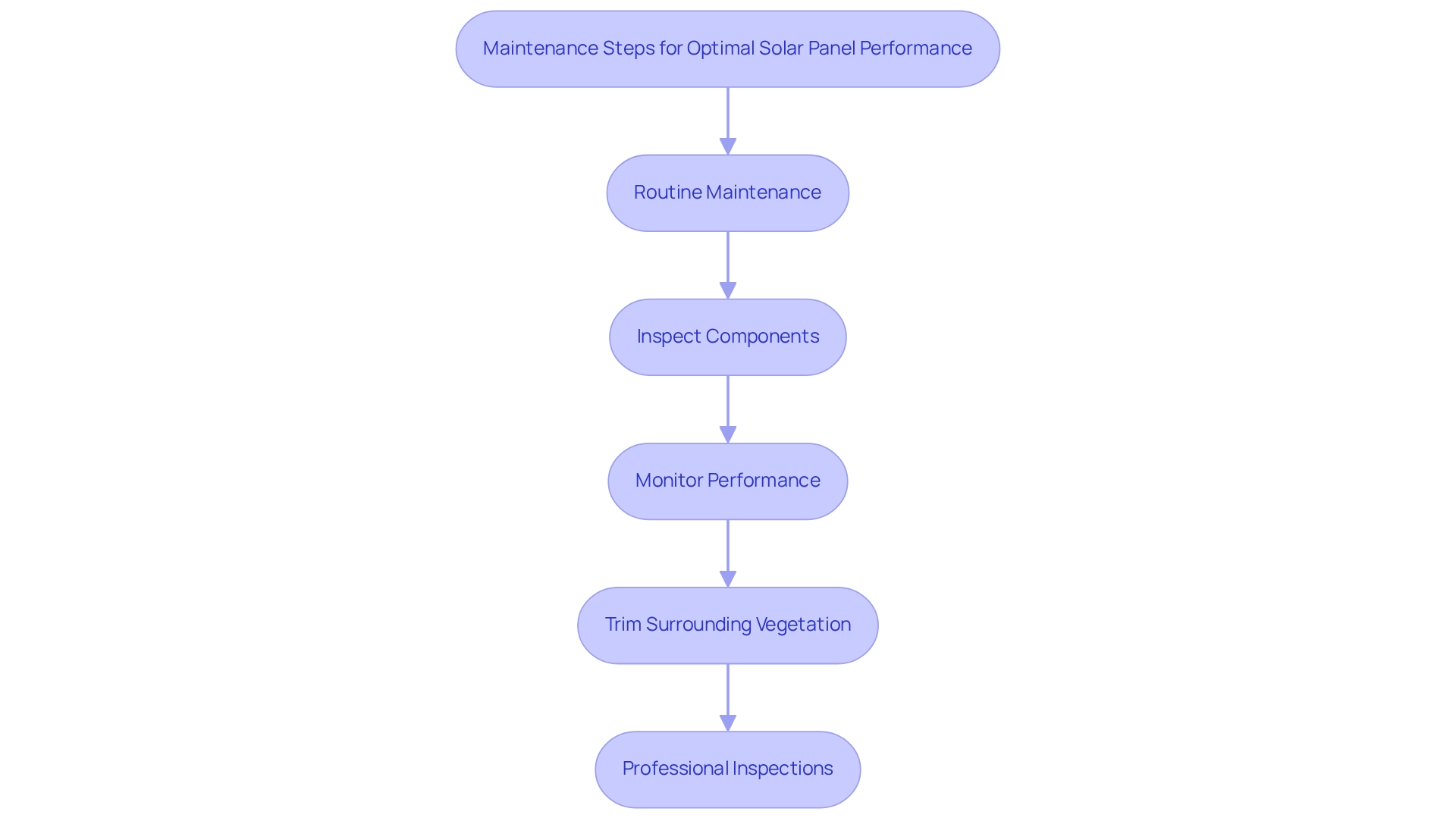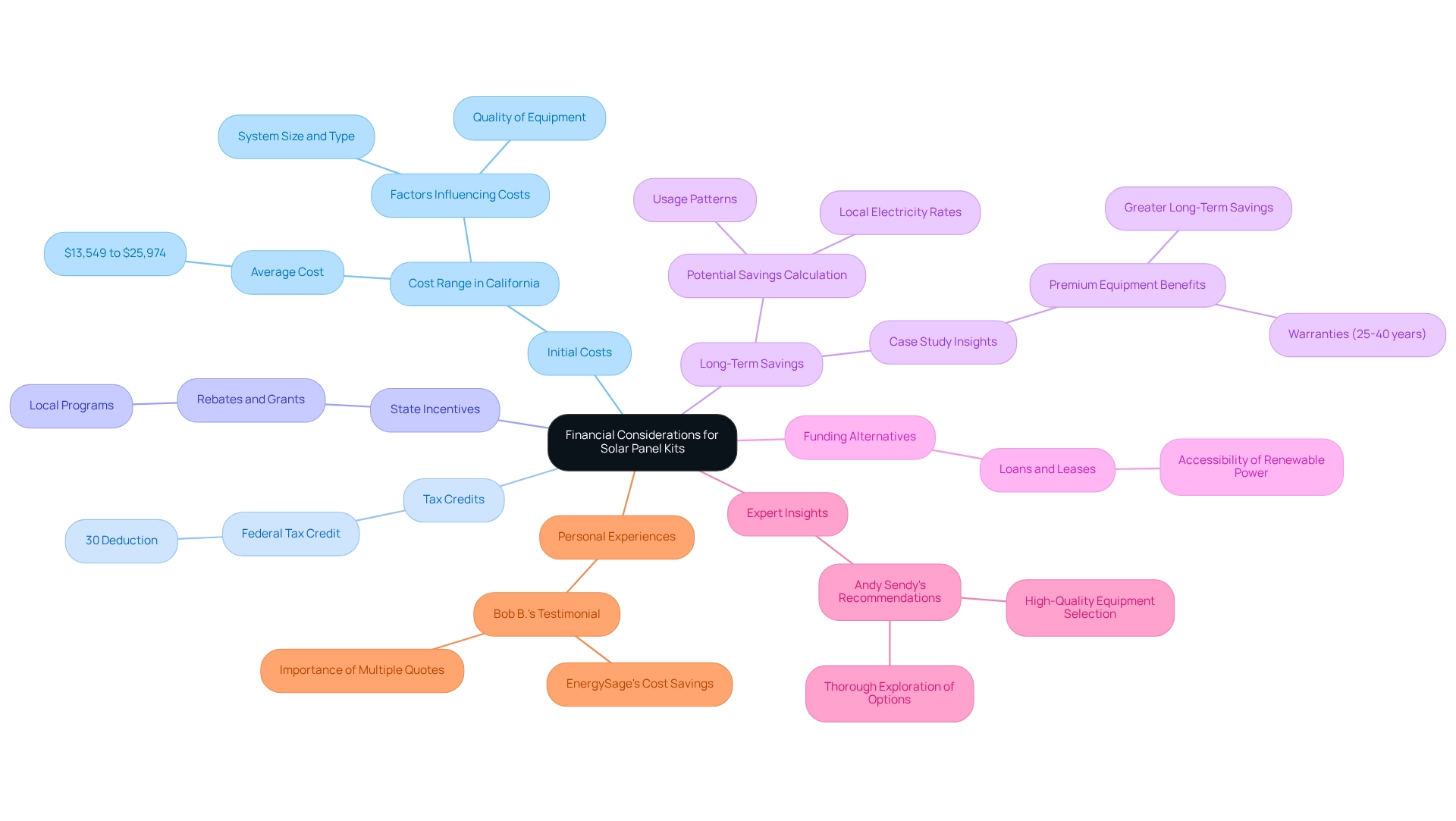Overview
Choosing and installing complete solar panel kits can feel overwhelming, especially when considering the rising energy bills that many families face. We understand that finding a solution that not only alleviates these costs but also contributes to a sustainable future is a priority for many homeowners. This article aims to guide you through the essential components of solar panel kits, such as photovoltaic modules and inverters, while also providing a step-by-step installation guide.
By embracing solar energy, you can achieve energy independence and enjoy significant cost savings in the long run. Imagine the peace of mind that comes with generating your own electricity, reducing your reliance on traditional energy sources. Additionally, we emphasize the importance of proper maintenance and highlight the financial incentives available to encourage you to invest in renewable energy solutions.
Together, we can make a positive impact on both your household budget and the environment. If you have any questions or need support, please reach out. We are here to help you navigate this journey towards a more sustainable and cost-effective energy solution.
Introduction
As homeowners, we often find ourselves grappling with the burden of rising energy bills. It’s common to feel overwhelmed by the costs associated with traditional energy sources. However, as the world increasingly shifts towards renewable energy, solar panel kits are emerging as a practical and empowering solution for those of us seeking to harness the sun’s power. These comprehensive systems not only promise substantial savings on electricity bills but also contribute to a sustainable future by reducing our carbon footprints.
With the global solar capacity reaching impressive heights, understanding the intricacies of solar panel kits has never been more crucial. Together, we can explore the essential components that make up these kits and the various types available. This article delves into the key factors to consider when embarking on your solar journey. Whether you’re aiming for energy independence or simply looking to cut costs, the insights provided will empower you to make informed decisions about your solar investments.
Let’s work towards a brighter, more sustainable future together.
Understanding Solar Panel Kits: An Overview
Complete solar panel kits are photovoltaic systems thoughtfully designed for home use, incorporating all the essential elements needed to capture sunlight efficiently. We understand that navigating energy expenses can be daunting, which is why these kits typically include photovoltaic modules, an inverter, mounting equipment, and wiring, simplifying the installation process for homeowners. Grasping the basics of solar technology is vital for those looking to lower power expenses and enhance their energy autonomy.
In 2025, homeowners can anticipate average savings of up to 30% on their electricity expenses after installing renewable energy systems, making this a financially wise investment. It’s heartening to see the uptake of renewable energy systems in households surge, with a significant rise in installations reflecting a growing awareness of the advantages of sustainable energy. Recent statistics reveal that the global photovoltaic capacity has reached an impressive 1,053.1 GW, underscoring the widespread shift towards renewable energy solutions.
Professionals highlight the importance of understanding renewable energy devices, as they not only offer immediate financial assistance but also contribute to long-lasting sustainability. Josh Jackman observes, “Grasping complete solar panel kits is essential for homeowners aiming to make informed decisions about their energy future.” Effective applications of photovoltaic systems have shown considerable decreases in power expenses while encouraging autonomy in power usage.
Furthermore, the advantages of photovoltaic panel kits extend beyond simple cost reductions. They provide homeowners the opportunity to invest in renewable resources, reduce their carbon footprint, and enhance the resilience of their power supply. The significance of photovoltaic battery backups cannot be overstated; they ensure reliable energy during power outages and adverse weather conditions, further solidifying the case for renewable investments.
For instance, Australia experienced a decline in photovoltaic installations in 2022, deploying 4 GW, a 34% decrease from the previous year due to challenging business conditions and rising component prices. Despite this decrease, Australia remains the nation with the highest renewable energy per capita, emphasizing the importance of understanding market dynamics when evaluating investments in this sector.
As the market evolves, ongoing research and development in photovoltaic technology continue to drive efficiency gains and cost reductions, making this form of power an increasingly appealing choice for homeowners. Together, we can see that energy systems represent a practical and efficient answer for those aiming to adopt sustainable power, offering both financial and ecological benefits. Let’s work towards a brighter, more sustainable future together.
Types of Solar Panel Kits: Which One is Right for You?
In 2025, homeowners are presented with a range of solar panel kits designed to meet their unique energy needs and applications, ensuring they feel supported in their choices:
-
Complete solar panel kits, often known as grid-tied kits, connect directly to the local utility grid, enabling homeowners to sell any surplus power back to the grid. This option is particularly beneficial for those eager to reduce their electricity bills without the additional cost of battery storage. Recent statistics reveal that about 70% of homeowners in California are choosing grid-tied systems, drawn by their cost-effectiveness and ease of installation. The estimated costs for various-sized solar systems, including one battery before tax credit, range from $26,000 to $56,000, making them an appealing choice for many. The economic advantages of these systems not only help families but also contribute to job creation and greenhouse gas reduction, aligning beautifully with sustainability goals.
-
Off-Grid Packages: Tailored for remote areas, off-grid packages come equipped with batteries to store energy for use during periods without sunlight. These systems are perfect for cabins or homes located where grid access is limited. Users share success stories that underscore the reliability of off-grid systems, particularly in rural settings where traditional power sources are absent. The integration of resource-efficient solutions in these setups promotes long-term sustainability and equitable access to power.
-
Hybrid Kits: These adaptable systems blend the features of both grid-tied and off-grid setups, allowing homeowners to utilize grid power while also benefiting from battery storage for backup. Hybrid packages, which include complete solar panel kits, are increasingly favored, especially among those seeking energy independence and reliability during outages. Market analysis indicates that hybrid photovoltaic kits are gaining significant traction in California, with an expected market share increase of 15% in 2025. The importance of battery capacity and power ratings in these systems cannot be overstated, as they are essential for effective resource management.
When selecting the right kit, it’s vital to consider factors such as power needs, geographical location, and budget constraints. Experts suggest that homeowners reflect on their long-term energy goals and potential savings when making this choice. Catherine Lane, the Written Content Manager at SolarReviews, emphasizes that understanding the unique benefits of each type of energy collection kit is crucial for making informed decisions that align with sustainability aspirations.
Furthermore, the “Application Segment Analysis of Residential Solar Power Systems Market” sheds light on technological innovations and future opportunities in the sector, further guiding homeowners in their choices. By grasping these dynamics, homeowners can make decisions that resonate with their sustainability objectives. Powercore Electric is committed to delivering high-quality installations and maintenance through its dedicated in-house team of experts, ensuring that clients receive reliable service tailored to their needs. Together, we can create a brighter, more sustainable future.
Key Components of Complete Solar Panel Kits
Understanding your concerns about rising energy bills is the first step toward finding a sustainable solution. A complete solar panel kit typically includes several essential components that work together to harness solar energy effectively:
- Solar Modules: The cornerstone of any solar kit, these devices convert sunlight into electricity. Offered in various forms, monocrystalline types are recognized for their high efficiency, frequently attaining average efficiency ratings of approximately 20-24%. With a 25-year guarantee, monocrystalline modules highlight their dependability. In contrast, polycrystalline modules provide somewhat reduced efficiency, making the decision between them essential based on your power requirements and budget. Notably, the Maxeon 7, provided by Powercore Electric, is presently the top photovoltaic module available, showcasing an impressive efficiency of 24.1%. For homeowners in overcast areas, choosing units intended to operate effectively in dim-light situations is crucial to enhance energy generation throughout the year.
- Inverter: This essential device converts the direct current (DC) produced by the photovoltaic units into alternating current (AC), which is the standard electricity utilized by most household appliances. The efficiency of inverters can greatly influence the overall performance of your energy system, with modern models featuring efficiencies surpassing 98%. As Jamie Smith, a content writer and researcher, notes, “The efficiency of photovoltaic systems is the percentage of the sun’s energy that strikes a photovoltaic unit that is transformed into electricity for your home.”
- Mounting Hardware: This component is essential for securely affixing the panels to your roof or ground. It must be durable and weather-resistant to endure various environmental conditions, ensuring the longevity and stability of your energy installation.
- Wiring: Proper wiring connects all components of the power system, facilitating efficient transfer. High-quality wiring is crucial to reduce power loss and ensure safety.
- Charge Controller: In off-grid systems, a charge controller regulates the voltage and current coming from the solar panels to prevent overcharging batteries. This component is essential for preserving battery health and enhancing power storage.
- Batteries: For systems that require power storage, batteries are essential. They store surplus power generated during sunny periods for use during cloudy days or at night, enhancing independence and reliability. The significance of photovoltaic battery backups cannot be overstated, particularly during power outages or severe weather conditions, ensuring that your home stays powered when it is most crucial.
Grasping these elements is essential for assessing various complete solar panel kits and ensuring you select one that meets your energy needs. Furthermore, funding alternatives, like power purchase agreements (PPAs) or direct acquisitions, can influence the choice of which type of photovoltaic system to select. As technology progresses, alternatives such as bifacial photovoltaic systems and PERC technology are arising, which can greatly improve electricity generation.
For example, bifacial systems can produce 5% to 45% more electricity than conventional modules, depending on installation conditions. This understanding enables homeowners to make informed choices regarding their power investments, ultimately lowering utility expenses, encouraging sustainability, and improving independence. Together, we can explore these options and find the best solution for your energy needs.
Factors to Consider When Choosing a Solar Panel Kit
When choosing a photovoltaic panel kit, we understand how important it is to consider various factors to ensure the system meets your household’s needs efficiently:
- Power Requirements: Begin by evaluating your household’s power usage. Take a look at your monthly electricity bills to estimate your average consumption. In California, the average household uses around 600 kWh monthly, so sizing your power system appropriately is essential. This consideration is especially crucial since transportation constitutes a substantial share of power usage in the state, highlighting the need for effective power solutions.
- Roof Space: Assess the available area on your roof for photovoltaic panels. It’s vital that the area receives sufficient sunlight throughout the day, as this significantly affects the efficiency of your energy system. A south-facing roof with minimal shading is typically ideal for photovoltaic installations.
- Budget: Determine your financial plan for the complete solar panel kits, including installation expenses. Consider potential savings from tax credits or incentives, which can significantly reduce your overall investment. With California’s commitment to sustainable resources, homeowners may discover various financial incentives available to support their transition to photovoltaic systems, such as those highlighted by the recent funding granted to the Viejas Tribe for sustainable resource projects. Additionally, local incentives and rebates for photovoltaic panel installation in Bakersfield can further encourage the adoption of renewable energy.
- Local Regulations: Familiarize yourself with local building codes and regulations regarding photovoltaic installations. These regulations can influence your options and may require permits or inspections, so ensuring compliance is essential to avoid any future complications.
- Warranty and Support: Choose kits that come with robust warranties and reliable customer support. A solid warranty can provide reassurance, ensuring that you have assistance if any issues arise with your power system.
Furthermore, it’s important to note that among homeowners who noticed a rise in utility rates, 87% took steps to lower their costs by turning off lights, switching to more efficient light sources (like LEDs), unplugging unused devices, and investing in energy-saving appliances. By thoughtfully evaluating these elements, together we can choose complete solar panel kits that are not only efficient but also tailored to your home’s specific needs, facilitating a successful transition to renewable energy.
Step-by-Step Installation Guide for Solar Panel Kits
Setting up complete solar panel kits can be a simple and fulfilling task when approached with care and attention. We understand that concerns about rising energy bills can weigh heavily on homeowners. Here’s a step-by-step guide designed to help you achieve a successful installation while paving the way for energy independence:
-
Gather Tools and Materials: Begin by collecting all necessary tools, including a drill, screwdriver, and safety gear. Review the kit’s manual for specific requirements to ensure you have everything needed for the installation.
-
Choose the Installation Location: Select a location that receives maximum sunlight throughout the day. It’s essential to ensure the area is structurally sound and free from obstructions, such as trees or buildings, that could cast shadows on the panels.
-
Install Mounting Hardware: Secure the mounting brackets to your roof or ground according to the manufacturer’s instructions. It’s crucial to ensure they are level and properly anchored to withstand environmental conditions.
-
Attach Photovoltaic Modules: Carefully install the photovoltaic modules onto the brackets, ensuring they are securely fastened. This step is vital for both safety and efficiency, as inadequately secured sections can lead to reduced performance. Remember that UV-induced degradation can decrease the efficiency of photovoltaic systems by 1-3% in the initial 1,000 hours, so proper installation is crucial to optimize performance.
-
Connect Wiring: Follow the wiring diagram included in the kit to link the photovoltaic modules to the inverter and other components. Ensure all connections are tight and secure to prevent power loss.
-
Install the Inverter: Position the inverter in a shaded location near the photovoltaic modules. This positioning helps maintain optimal performance and connects it to your electrical system.
-
Test the System: Once everything is connected, turn on the system and check for proper operation. Monitor the output to ensure it is functioning as expected. Routine testing can assist in recognizing any problems promptly.
By following these steps, you can achieve a successful setup of your complete solar panel kits, leading to energy independence and reduced utility costs. While DIY installations can be fulfilling, remember that consulting with professionals can enhance safety and reliability, ensuring your system operates at peak efficiency.
The renewable energy sector is currently facing rising competition, which is anticipated to result in reduced costs and more efficient power modules. However, it’s common to feel uncertain about the energy market, especially with recent executive orders affecting funding from the Inflation Reduction Act. Adopting renewable energy not only provides immediate cost advantages but also contributes to a sustainable future, making it a valuable investment. Together, we can work towards a brighter, more sustainable tomorrow.
Troubleshooting Common Installation Issues
When setting up photovoltaic systems, we understand that homeowners may encounter several common challenges that can impact efficiency and dependability. Here are some effective troubleshooting tips to help you navigate these concerns:
-
Insufficient Sunlight: If your energy collectors are underperforming, the first step is to evaluate possible shading from nearby trees or structures. Cutting back protruding branches or moving panels to brighter areas can greatly enhance power generation. Did you know that even minor shading can lead to performance drops of up to 20%? Furthermore, it’s essential to confirm that your installation zone has adequate space, as industrial energy setups require large areas for rooftop or ground-mounted systems, emphasizing the necessity for sufficient sunlight exposure.
-
Loose Connections: Check all wiring connections to ensure they are secure. Loose connections can lead to power loss or even system failure, which can be easily prevented with a thorough inspection.
-
Inverter Issues: If the inverter is not functioning correctly, consult the manual for error codes. Ensure that it is properly connected and powered. Inverters are vital for transforming the produced sunlight into usable electricity, so addressing any issues quickly is important.
-
Mounting Issues: Securely affixed surfaces are essential for optimal performance. Inspect the brackets and ensure they are properly anchored. Re-tightening any loose screws can prevent potential damage during adverse weather conditions.
-
Weather Conditions: It’s common to feel hesitant about installation during inclement weather. Rain or high winds can complicate the process and pose safety risks. Planning installations during favorable weather can lead to a smoother experience.
By anticipating these common problems and applying these troubleshooting suggestions, you can improve your installation experience, ensuring dependable power generation and increased independence. Furthermore, combining photovoltaic panels with battery storage can further reduce the intermittent nature of sunlight power, enabling usage during nighttime or outages. This combination not only improves power reliability but also enhances your autonomy, making photovoltaic power a more feasible choice for homeowners in regions with regular power interruptions.
Moreover, recognizing that the worth of photovoltaic installations can differ depending on local regulations and accessible incentives is essential for homeowners contemplating this investment. As Jamie Smith, a Content Specialist, observes, “Renewable resources refer to sources of power that naturally replenish themselves within a human lifetime,” highlighting the significance of sunlight as a sustainable option. Finally, it’s crucial to acknowledge that photovoltaic systems generate electricity via the photovoltaic effect, and any surplus energy can be directed to the utility grid or stored in a battery, maximizing the advantages of your renewable energy investment.
Maintaining Your Solar Panel Kit for Optimal Performance
To ensure your solar panel kit from Powercore Electric operates at peak efficiency, we understand that it’s important to adhere to some straightforward maintenance tips:
-
Routine Maintenance: We encourage you to clean the photovoltaic surfaces at least twice a year. This simple act helps eliminate grime, dust, and waste that can hinder sunlight. A gentle cloth or sponge with water is perfect; please avoid strong chemicals that might harm the surfaces. Regular cleaning is essential, as studies show that neglecting this can lead to a reduction in power output. In fact, experts observe that well-maintained solar panels can sustain production at 80% or higher for 15 to 25 years. As one expert pointed out, “Did you observe a significant decline in power production?” This issue can arise from various factors, the most common being dust and debris buildup. However, malfunctioning components can also be at fault. The most effective method to ascertain the cause is through the process of elimination, starting with cleaning the surface. If that doesn’t resolve the issue, it’s time to schedule maintenance with professionals.
-
Inspect Components: It’s wise to regularly examine all components, including wiring and the inverter, for any signs of wear or damage. Promptly addressing these issues can prevent more significant problems down the line.
-
Monitor Performance: Keep a close watch on your system’s power output. A significant drop in performance may indicate underlying issues that need your attention. Experts note that a decline in energy production is often linked to dust and debris buildup, making routine maintenance crucial.
-
Trim Surrounding Vegetation: Ensure that trees or shrubs do not obstruct sunlight from reaching the surfaces. Regularly trimming any overhanging branches will help maintain optimal exposure.
-
Professional Inspections: We recommend scheduling a professional inspection every few years to ensure that all components are functioning correctly and safely. This is especially vital as the renewable energy sector advances, and state incentives can enhance demand for this energy source, making efficient maintenance even more essential.
Moreover, researchers from the Indian Institute of Engineering Science and Technology have created a model to estimate dust buildup on photovoltaic surfaces, which is essential for both rooftop and commercial installations. By applying these upkeep methods, you can prolong the longevity of your system kit and optimize its power output, guaranteeing a sustainable power solution for your residence. Recent insights highlight the significance of maintaining clean energy surfaces; even slight performance declines can accumulate over time, impacting overall efficiency. Together, we can ensure your solar energy system remains a reliable source of power for your home.
Cost Considerations and Financial Incentives for Solar Panel Kits
When considering solar panel kits, it’s essential to address the costs involved and the financial incentives available that could ease your transition to renewable energy:
- Initial Costs: We understand that investing in a residential photovoltaic panel system can feel daunting. In 2025, the average expense in California ranges from $13,549 to $25,974, influenced by factors like system size and type. This investment can vary significantly based on the quality of equipment selected, especially if you’re considering options that integrate with EV charging solutions offered by Powercore Electric.
- Tax Credits: It’s reassuring to know that homeowners can take advantage of federal tax credits, allowing them to deduct up to 30% of their installation costs for renewable energy systems from their federal tax bill. This incentive can significantly lessen the financial burden associated with adopting renewable power, making it a more appealing choice compared to traditional electricity.
- State Incentives: Alongside federal credits, many states, including California, provide various incentives such as rebates and grants to encourage the use of renewable power. Investigating local programs can unveil additional savings options that enhance the financial feasibility of renewable energy investments, particularly for environmentally conscious homeowners eager to maximize their benefits.
- Long-Term Savings: Switching to renewable power can lead to substantial savings on electricity expenses over time. We encourage homeowners to calculate potential savings based on their usage patterns and local electricity rates, as these factors will influence your return on investment. As noted in a case study, investing in premium energy equipment from Powercore Electric can yield greater long-term savings and reliability, with warranties often covering 25 to 40 years.
- Funding Alternatives: To make renewable power more accessible, Powercore Electric offers various funding options, including loans and leases for photovoltaic systems. These alternatives enable homeowners to embrace renewable solutions without the stress of a hefty initial cost, facilitating the shift to sustainable power and incorporating EV charging systems into their homes.
- Expert Insights: Andy Sendy, a trusted figure in the renewable energy sector with over 15 years of experience, underscores the importance of selecting high-quality equipment to maximize energy production. He recommends that homeowners thoroughly explore their options before making a decision, especially when assessing the effectiveness of renewable energy systems and their compatibility with home EV chargers.
- Personal Experiences: As Bob B., a satisfied customer, shares, “EnergySage saved me a ton of money by helping me get bids that were half the cost of the bids I got myself by calling around. I can’t say enough good about this organization. Don’t invest in renewable energy without it!” This highlights the value of obtaining multiple quotes to ensure the best deal, particularly in a competitive market.
By thoroughly understanding these financial considerations and leveraging available resources, we can empower homeowners to make informed decisions regarding their investment in solar panel kits and EV charging solutions from Powercore Electric. Together, we can work towards enhanced energy independence and significant cost savings.
Conclusion
We understand that rising energy costs can be a significant concern for homeowners, weighing heavily on your finances. The shift towards solar energy offers a promising solution, allowing you to alleviate this burden while making a positive impact on the environment. Solar panel kits are comprehensive systems designed to empower you to harness the sun’s energy effectively, leading to substantial savings on electricity bills and fostering a sense of energy independence. By exploring the various types of kits available—grid-tied, off-grid, and hybrid—you can select the option that best aligns with your energy needs and financial goals.
Key components such as solar panels, inverters, and batteries play crucial roles in ensuring the overall efficiency and functionality of these systems. Regular maintenance, including cleaning and inspections, is vital to ensure optimal performance and longevity. It’s common to feel overwhelmed by the financial landscape surrounding solar investments, which encompasses initial costs, tax credits, state incentives, and long-term savings. However, being well-informed is essential for a successful transition to solar energy.
In conclusion, embracing solar panel kits is not just a practical choice; it is a significant step towards a sustainable future. By investing in solar technology, you contribute to reducing your carbon footprint while enjoying the financial benefits that come with renewable energy. Together, we can embark on this journey towards energy independence and sustainability. Now is the time to take action and secure a brighter, more sustainable future for ourselves and generations to come.


